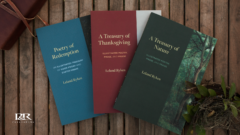This is week two of our reading project. We are reading our way through John Murray’s Redemption Accomplished and Applied, a classic text that provides a thorough treatment of the doctrine of the atonement. Murray is not a man to waste a word, so this book is dense; but he is also a brilliant theologian, so it is well worth the sometimes-difficult read. It is work, but the pay-off is huge.
If you would like to join in the fun, there is still lots of time to do so. You’re only two chapters behind. Simply find a copy of the book and get reading!
Summary
This week’s chapter dealt with the nature of the atonement. I’m not sure that I fully understood the big picture of this chapter but if I did, it went like this. Murray went looking for an “inclusive rubric” under which he could place the atonement. The atonement includes specific categories used to describe Christ’s work: things like sacrifice, propitiation, reconciliation and redemption. But he sought to find a heading under which he could place even these terms. The term he settled upon is obedience. “The Scripture…uses this term, or the concept it designates, with sufficient frequency to warrant the conclusion that obedience is generic and therefore embracive enough to be viewed as the unifying or integrating principle.” This leads to a discussion of the difference between Christ’s active obedience and his passive obedience. Murray offers some valuable keys to understanding passive obedience, which I will lead you to read or review on your own. A few things stood out to me in this section, including this: “When we speak of the death of our Lord on the cross as the supreme act of his obedience we are thinking not merely of the overt act of dying upon the tree but also of the disposition, will, and determinate volition which lay back of the overt act.” When we speak of Christ’s passive obedience, we do not speak of passivity, for in all things Christ had a determined will and a determined disposition.
After this discussion of obedience as the “inclusive category in terms of which the atoning work of Christ may be viewed and which establishes at the outset the active agency of Christ in the accomplishment of redemption” he turns to the specific categories the Bible uses to set forth the nature of the atonement.
First, he looks at sacrifice. He says it is a given that Christ’s work is construed as sacrifice so the only real question here is this: what notion of sacrifice governs this pervasive use of the term as it is applied to the work of Christ? This leads to a lengthy discourse on how the New Testament writers would have understood the term based on their cultural and religious setting. “The work of Christ,” he says, “is expiatory, expiatory indeed with a transcendent virtue, efficacy.” Last week I mentioned that Murray can be difficult to read. I leave this sentence as evidence: “It is this amazing conjuncture that the union in him of priestly office and piacular offering evinces.”
Second, he looks at propitiation saying “the idea of propitiation is so woven into the fabric of the Old Testament ritual that it would be impossible to regard that ritual as the pattern of the sacrifice if propitiation did not occupy a similar place in the one great sacrifice once offered.” In other words, sacrifice and propitiation are very closely related to one another. He offers a lengthy but helpful definition of propitiation which includes the idea of “covering.” He carefully shows that sin creates a situation in which we are estranged from God but, even more importantly, in which God is estranged from us. Then he says, “Vengeance is the reaction of the holiness of God to sin, and the covering is that which provides for the removal of divine displeasure which the sin evokes.” Further, “Propitiation presupposes the wrath and displeasure of God, and the purpose of propitiation is the removal of this displeasure.”
Third, he turns to reconciliation. “Reconciliation presupposes disrupted relations between God and men. It implies enmity and alienation. This alienation is twofold, our alienation from God and God’s alienation from us. The cause of the alienation is, of course, our sin, but the alienation consists not only in our unholy enmity against God but also in God’s holy alienation from us.”
Fourth and finally, he looks to redemption. He says, “The language of redemption is the language of purchase and more specifically of ransom. And ransom is the securing of a release by the payment of a price.” He warns, though, that we cannot follow this term too far into its parallels with human transactions, lest our constructions become artificial and fanciful. He looks here to law and sin as the means to understand why an act of redemption was necessary within God’s economy. Having shared what Scripture says he concludes “redemption from sin cannot be adequately conceived or formulated except as it comprehends the victory which Christ secured once for all over him who is the god of this world, the prince of the power of the air, the spirit that now works in the children of disobedience.”
So, at this point Murray has looked at both the necessity and the nature of the atonement. He continues to lay the groundwork for his eventual examination of the application of redemption. But before he can get there, there are a few more foundational matters to attend to. We will look at those over the next three weeks.
Next Week
For next Thursday please read chapter three, “The Perfection of the Atonement.”
Your Turn
The purpose of this program is to read classics together. So if there are things that stood out to you in this chapter, if there are questions you had, this is the time and place to have your say. Feel free to post a comment below.










